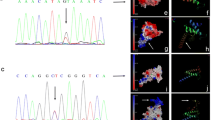Summary
A genetic study of 598 patients with retinoblastoma was made-10.5% were familial, 36% had the bilateral form. The data confirmed that these two forms differ in their mode of inheritance; the bilateral are due to a germinal dominant mutation, whereas the unilateral are due in most cases to a somatic mutation and are therefore non-hereditary. The recurrence risk among the offspring of sporadic unilateral cases amounts to 1.2–11.8%.
The incidence of the disease among the sibs of sporadic cases is higher if the index case has a bilateral form (6.2% vs. 0.6%). Contrarily, the incidence is higher among the offspring of normal sibs when the index case has a unilateral form.
The incidence of the retinoblastoma has been estimated at 5x10-5 in a French population with a mutation rate of 5x10-6.
Knudson has developed the hypothesis that retinoblastoma is caused by two mutational events. In the dominantly inherited form one mutation is germinal, the second occurs in the retinal cells. In the non-heritary form both occur in somatic cells. Knudson's hypothesis accounts reasonably well for the familial distribution of retinoblastoma but does not correlate with the proportion of healthy carriers and changes of penetrance.
The hypothesis is put forward that premutational events responsible for these changes of penetrance include chromosomal breakages susceptible to repair or to further evolution to deletion.
Résumé
Une étude familiale portant sur 598 rétinoblastomes dont 10,5% sont familiaux et 36% bilateraux, a permis de confirmer que tous les rétinoblastomes bilatéraux sont la conséquence de mutations germinales anciennes ou récentes, donc héréditaires et se transmettent selon le mode dominant autosomique avec un risque de 50% pour les descendants; quant aux rétinoblastomes unilatéraux, une partie seulement est héréditaire, la grande majorité étant due à des mutations somatiques non transmissibles; aucun élément ne perment de distinguer les deux formes lorsqu'il s'agit d'un cas isolé et le risque pour la descendance est inférieur à 10% (1,2 à 11,8% selon les enquêtes).
Dans les cas dits sporadiques, le risque de récurrence est plus élevé pour les germains des formes bilatérales que pour ceux des formes unilatérales (6,2 et 0,6%); il est faible pour les descendants des germains sains d'unilatéraux (0,4%) et certainement nul pour ceux des bilatéraux.
La fréquence en France peut être estimée entre 4 et 5x10-5 et le taux de mutation à 5x10-6.
La théorie mutationnelle de Knudson selon laquelle le rétinoblastome serait la conséquence de deux mutations affectant la même cellule rétinienne, deux mutations somatiques dans les formes non héréditaires, une mutation germinale suivie d'une mutation somatique dans les formes héréditaires rend assez bien compte de la distribution familiale, mais n'explique pas les variations de pénétrance et la forte proportion de porteurs sains (16% des formes héréditaires). L'hypothèse d'une prémutation consistant en une cassure transmissible et pouvant aboutir à une délétion est avancée.
Similar content being viewed by others
Bibliographie
Ashley, D. J. B.: The two “hit” and multiple “hit” theories of carcinogenesis. Brit. J. Cancer 23, 313–328 (1969)
Auerbach, C.: A possible case of delayed mutation in man. Ann. hum. Genet. 20, 266–269 (1956)
Bonaïti-Pellié, C., Briard-Guillemot, M. L., Feingold, J., Frézal, J.: Associated congenital malformation in retinoblastoma. Clin. Genet. (à paraître)
Böhringer, H. R.: Statistik, Klinik und Genetik der Schweizerischen Retinoblastomfälle 1925–1954. Arch. Klaus-Stift. Vererb.-Forsch. 31, 1–16 (1956)
Dollfus, M. A., Auvert, B.: Le gliome de la rétine et les pseudo-gliomes. Paris: Masson et Co. 1953
Falls, H. F., Neel, J. V.: Genetics of retinoblastoma. Arch. Ophthal. 46, 367–389 (1951)
Franceschetti, A., Bischler, V.: Rétinoblastome et hérédité. Arch. Klaus-Stift. Vererb.-Forsch. 21, 322–328 (1946)
Frézal, J., Briard-Guillemot, M. L.: A propos de l'hérédité du rétinoblastome. In: Journées Parisiennes de pédiatrie, pp. 175–186. Paris: Editions Médicales Flammarion 1970
Frézal, J., Dollfus, M. A., Lamy, M., Guillemot, M. L., Coblentz, L., Laurent, C., Kelley, J., Evrard, J.: Résultats d'une enquête étiologique sur le rétinoblastome. Ann. Oculist. (Paris) 159, 1189–1211 (1965)
Knudson, A. G.: Mutation and cancer: statistical study of retinoblastoma. Proc. nat. Acad. Sci. (Wash.) 68, 820–823 (1971)
Knudson, A. G., Strong, L. C.: Mutation and cancer: a model for Wilm's tumor of the kidney. J. nat. Cancer Inst. 48, 313–324 (1972)
Macklin, M. T.: A study of retinoblastoma in Ohio. Amer. J. hum. Genet. 12, 1–43 (1960)
Neel, J. V.: Mutations in the human population. In: Methodology in human genetics (ed. W. J. Burdette), pp. 203–279. San Francisco: Holden Day, Inc. 1962
Nielsen, M., Goldschmidt, E.: Retinoblastoma among offspring of adult survivors in Denmark. Acta ophthal. (Kbh.) 46, 736–741 (1968)
Pellié, C., Briard, M. L., Feingold, J., Frézal, J.: Parental age in retinoblastoma. Humangenetik 20, 59–62 (1973)
Schappert-Kimmijser, J., Hemmes, G. D., Nijland, R.: The heredity of retinoblastoma. Ophthalmologica (Basel) 151, 197–213 (1966)
Sorsby, A.: Bilateral retinoblastoma: a dominantly inherited affection. Brit. med. J. 1972 II, 580–583
Tucker, D. P., Streinberg, A. G., Cogan, D. G.: Frequency of genetic transmission of sporadic retinoblastoma. Arch. Ophthal. 57, 532–535 (1957)
Vogel, F.: Über Genetik und Mutationsrate des Retinoblastoms (Glioma retinae). Z. menschl. Vererb.-u. Konstit.-Lehre 32, 308–336 (1954)
Vogel, F.: Neue Untersuchungen zur Genetik des Retinoblastoms (Glioma retinae). Z. menschl. Vererb.-u. Konstit.-Lehre 34, 205–236 (1957)
Vogel, F.: Genetic prognosis in retinoblastoma. In: Modern trends in ophthalmology (ed. A. Sorsby), pp. 34–42. London: Butterworths 1967
Vogel, F.: Spontaneous mutation in man. In: Chemical mutagenesis in mammals and man (eds. F. Vogel, G. Röhrborn), pp. 16–68. Berlin-Heidelberg-New York: Springer 1970
Vogel, F.: Genotype and phenotype in human chromosome aberrations and in the minute mutants of drosophila melanogaster. Humangenetik 19, 41–56 (1973)
Author information
Authors and Affiliations
Additional information
Ce travail est réalisé avec l'aide d'un contrat I.N.S.E.R.M. Nous remercions tout particulièrement le Docteur Haye et les médecins de la Fondation Curie (Paris), le Professeur Paufique (Lyon), le Professeur François (Lille) ainsi que tous les ophtalmologistes, les radiothérapeutes, les ocularistes qui nous ont permis de réaliser ce travail.
Rights and permissions
About this article
Cite this article
Briard-Guillemot, M.L., Bonaïti-Pellié, C., Feingold, J. et al. Étude génétique du rétinoblastome. Hum Genet 24, 271–284 (1974). https://doi.org/10.1007/BF00297591
Received:
Accepted:
Published:
Issue Date:
DOI: https://doi.org/10.1007/BF00297591




